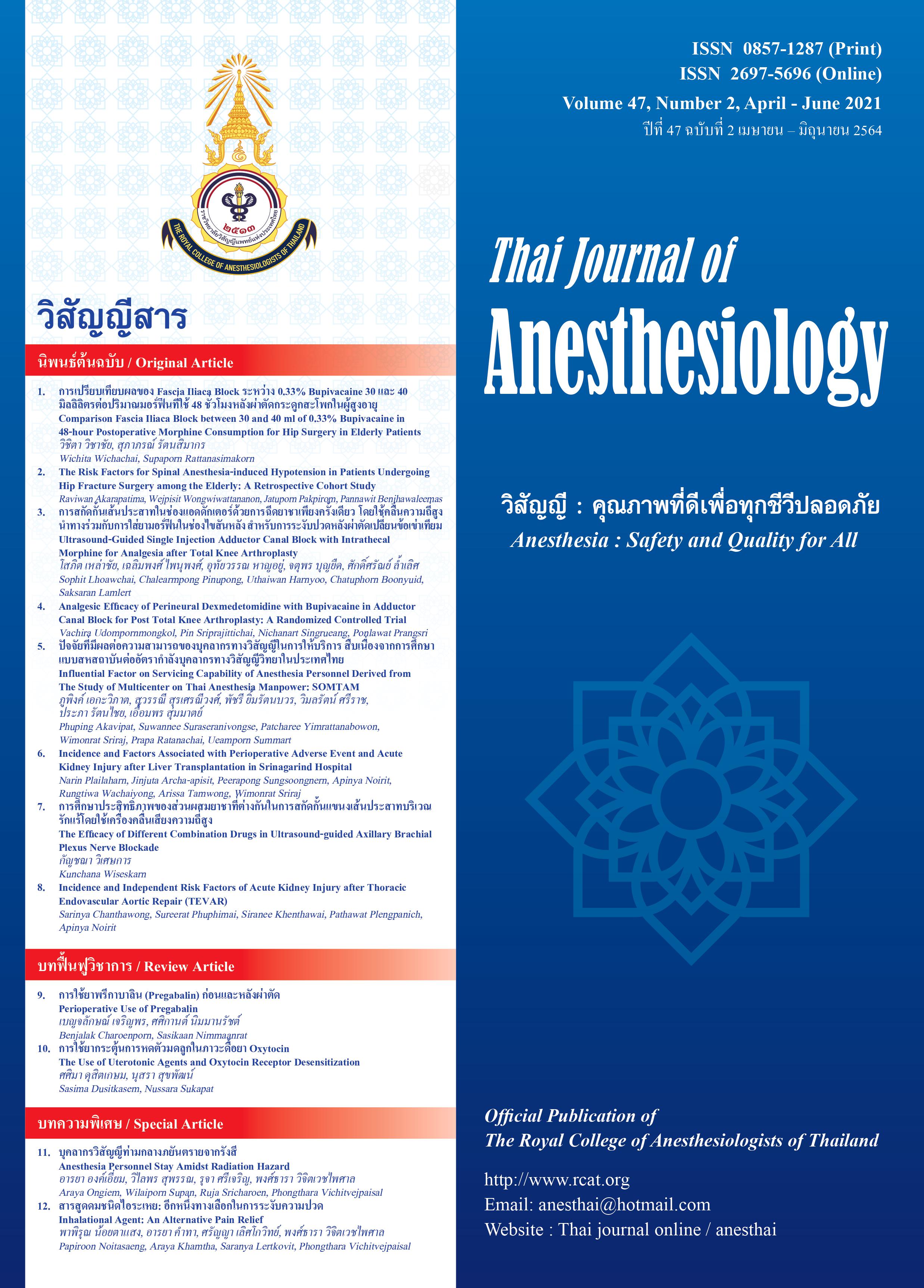The Risk Factors for Spinal Anesthesia-induced Hypotension in Patients Undergoing Hip Fracture Surgery among the Elderly: A Retrospective Cohort Study
Main Article Content
Abstract
Introduction: Hip fractures are increasing as the population ages, this is becoming a major public health problem, increasing the burden of all countries. Hip fracture surgery can be undertaken with spinal anesthesia; however, hypotension is the most common side effect of this technique. Spinal anesthesia-induced hypotension, even when treated, can lead to deterioration of the organs and systemic diseases. Objective: We aimed to examine the modifiable risk factors of pre-operative hypotension among elderly patients, who underwent hip fracture surgery utilizing spinal anesthesia. Materials and Methods: A retrospective cohort study was conducted in a university hospital, Thailand. Hip fracture patients who underwent hip fracture surgery under spinal anesthesia between; January 2014 and June 2019, were enrolled in this study. We collected patient characteristic, premedication, anesthetic factors and surgical factors from anesthetic and medical records of the hospital information system, and statistical analysis was performed using R program. Results: From the 186 patients, the incidence of spinal anesthesia-induced hypotension was 46.8%. The dependent risk factors with increased risk of hypotension after spinal anesthesia were; increasing age, decreasing of baseline systolic blood pressure, American Society of Anesthesiologists (ASA) classification 3, sensory analgesia; equal to or higher than T5 (adjusted odd ratio; adj. OR=7.16), and those who received antihypertensive drugs more than 1 type as premedication (adj. OR= 6.91). Conclusion: The number of antihypertensive drugs for premedication, and sensory analgesia were modifiable risk factors of hypotension after spinal anesthesia in hip fracture surgery.
Article Details
References
blocks for hip fractures: A Cochrane review. Anesthe Analg
2018;126:1695-704.
2. Kowark A, Rossaint R, Coburn M. General versus spinal
anesthesia for the elderly hip fractured patient. Curr Opin
Anaesthesiol 2019;32:116-9.
3. Guay J, Parker MJ, Gajendragadkar PR, Kopp S. Anaesthesia
for hip fracture surgery in adults. Cochrane Database Syst
Rev 2016;2:CD000521
4. Taheriazam A, Saeidinia A, Keihanian F. Total hip arthroplasty
and cardiovascular complications: a review. Ther Clin Risk
Manag 2018;14:685-90.
5. Chiang C-H, Liu C-J, Chen P-J, et al. Hip fracture and risk
of acute myocardial infarction: A nationwide study. J Bone
Miner Res 2013;28:404-11.
6. Kowark A, Adam C, Ahrens J, et al. Improve hip fracture
outcome in the elderly patient (iHOPE): a study protocol for
a pragmatic, multicentre randomised controlled trial to test
the efficacy of spinal versus general anaesthesia. BMJ Open
2018;8:e023609.
7. Kim BS, Kim TH, Oh JH, et al. Association between preoperative
high sensitive troponin I levels and cardiovascular events
after hip fracture surgery in the elderly. J Geriatr Cardiol
2018;15:215-21.
8. Kelly JD, McCoy D, Rosenbaum SH, Brull SJ. Haemodynamic
changes induced by hyperbaric bupivacaine during lateral
decubitus or supine spinal anaesthesia. Eur J Anaesthesiol
2005;22:717-22.
9. Nakasuji M, Suh SH, Nomura M, et al. Hypotension from
spinal anesthesia in patients aged greater than 80 years is
due to a decrease in systemic vascular resistance. J Clin
Anesth 2012;24:201-6.
10. Martyr JW, Clark MX. Hypotension in elderly patients
undergoing spinal anaesthesia for repair of fractured neck
of femur, a comparison of two different spinal solutions.
Anaesth Intensive Care 2001;29:501-5.
11. Jang WY, Jung JK, Lee DK, Han SB. Intraoperative hypotension
is a risk factor for postoperative acute kidney injury after
femoral neck fracture surgery: a retrospective study. BMC
Musculoskelet Disord 2019;20:131.
12. White SM, Moppett IK, Griffiths R, et al. Secondary analysis
of outcomes after 11,085 hip fracture operations from the
prospective UK anaesthesia sprint audit of practice (ASAP-2).
Anaesthesia 2016;71:506-14.
13. Roshanor PS, Rochwers B, Patel A, et al. Withholding versus
continuing angiotensin-converting enzyme inhibitors or
angiotensin II receptor blockers before noncardiac
surgery:an analysis of the vascular events in noncardiac
surgery patients cohort evaluation prospective cohort.
Anesthesiology 2017;126:16-27.
14. Ohpasanon P, Chinachoti T, Sriswasdi P, Srichu S. Prospective
study of hypotension after spinal anesthesia for cesarean
section at Siriraj Hospital: incidence and risk factors, part 2.
J Med Assoc Thai 2008;91:6.
15. Chinachoti T, Tritrakarn T. Prospective study of hypotension
and bradycardia during spinal anesthesia with bupivacaine:
incidence and risk factors, part two. J Med Assoc Thai
2007;90:492-501.
16. Carpenter RL, Caplan RA, Brown DL, Stephenson C, Wu R.
Incidence and risk factors for side effects of spinal anesthesia.
Anesthesia 1992;76:906-16.
17. Hartmann B, Junger A, Klasen J, et al. The incidence and
risk factors for hypotension after spinal anesthesia induction:
an analysis with automated data collection. Anesth Analg
2002;94:1521-9.
18. van Beek AH, Claassen JA, Rikkert MGO, Jansen RW. Cerebral
autoregulation: an overview of current concepts and
methodology with special focus on the elderly. J Cereb Blood
Flow Metab 2008;28:1071-85.
19. Pereira IDF, Grando MM, Vianna PTG, et al. Retrospective
analysis of risk factors and predictors of intraoperative
complications in neuraxial blocks at Faculdade de Medicina
de Botucatu-UNESP. Rev Bras Anestesiol 2011;61:568-81.
20. Tarkkila P, Isola J. A regression model for identifying patients
at high risk of hypotension, bradycardia and nausea during
spinal anesthesia. Acta Anaesthesiol Scand 1992;36:554-8.
21. Kyokong O, Charuluxananan S, Sriprajittichai P, Poomseetong
T, Naksin P. The incidence and risk factors of hypotension
and bradycardia associated with spinal anesthesia. J Med
Assoc Thai 2006; 89 (Suppl 3):S58-64.


